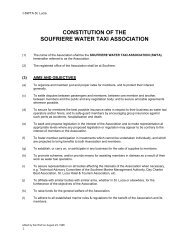WWF Cover photo - Soufriere Marine Management Association ...
WWF Cover photo - Soufriere Marine Management Association ...
WWF Cover photo - Soufriere Marine Management Association ...
You also want an ePaper? Increase the reach of your titles
YUMPU automatically turns print PDFs into web optimized ePapers that Google loves.
11. Mombasa and Kisite <strong>Marine</strong> Parks, KenyaKenya has a long history of using marine reserves to protect coastal areas, promote tourism and more recently tomanage fisheries (Obura 2001). At the moment marine protected areas account for about 5% of Kenya’snearshore area (Muthiga et al. 2000). The approach used most widely in Kenya has been to protect core zonesfrom all fishing (marine parks) and to place regulated buffer zones where traditional fishing methods arepermitted (marine reserves) around the parks (Obura 2001). Two marine parks have been particularly wellstudied since their establishment, the Mombasa <strong>Marine</strong> National Park and the Kisite <strong>Marine</strong> National Park. Ingeneral, reef fishery catches in Kenya, and elsewhere in East Africa, for example Tanzania, have declined overrecent decades (Muthiga et al. 2000, McClanahan and Mangi 2001). Many poor coastal people in the region aredependent to some extent on nearshore coastal resources and their sustainable management is therefore veryimportant. As tourism is an important part of the economy in Kenya, it is also necessary to manage potentialconflicts between tourism and fisheries sectors.The Mombasa <strong>Marine</strong> National ParkThe Mombasa <strong>Marine</strong> National Park (MMNP) is in the south of Kenya and now has an area of 6.2km 2 . It wasestablished in 1987 as a no-take protected area and before its establishment the area was very heavily exploited.Some fishing continued in the park until 1991, and illegal fishing remains a problem (McClanahan and Kaunda-Arara 1996). When active management of the park began in 1991, 63% of the fishing grounds were designatedas no-take areas and fishing effort decreased by an estimated 68% so fishing effort per unit area stayedapproximately the same (McClanahan and Kaunda-Arara 1996). The available fishing grounds for fishersoperating from the main local landing site, Kenyatta beach, decreased from 8km 2 to 3km 2 , and the number offishers reportedly decreased from 100 to 35.Little information is available on the direct impact of the creation of the Mombasa <strong>Marine</strong> Park on fishers.However, according to McClanahan and Kaunda-Arara (1996) nearly a third of the fishers from the Kenyattalanding site either moved to fishing from another site or gave it up, suggesting that these fishers are likely tohave suffered some serious negative effects. Through interviews with fishers, Rodwell (2001) found that one ofthe main impacts of the park on fishing costs was the increased cost of transport to the new landing sites thatsome displaced fishers moved to. In view of these problems it is not surprising that the early history of the parkwas turbulent. In 1995 conflicts associated with the closed area were tackled by a new management plan toreduce the size of the park and ban the use of beach seines. The park was reduced from an initial area of 8.2km 2to 6.2km 2 , by moving the northern boundary south by 1km and the southern border north (McClanahan andMangi 2000). Since then the relationship between fishers and park management has improved (Glaesel 1997 inMcClanahan and Mangi 2001).The area to the south of the MMNP was established as the Mombasa <strong>Marine</strong> Reserve (MMR) where only thosefishing methods considered traditional – traps, gill nets, handlines and octopus spears – were permitted. The areaof the Mombasa <strong>Marine</strong> Reserve is approximately 12km 2 . It took several years for these regulations to beimplemented and the exclusive use of permitted fishing gears started in 1994 with varying levels of enforcementsuccess (McClanahan and Kaunda-Arara 1996, McClanahan pers.comm.).McClanahan and Kaunda-Arara’s (1996) underwater study of fish populations showed large differences betweenprotected and unprotected reefs. Most fish showed some recovery inside the park after fishing was banned.Surgeonfish (Acanthuridae) decreased in biomass per hectare from 1988 to 1992, but then increased rapidly to1994 in the protected area. Triggerfish (Balistidae) increased between 1988 and 1994 by 5 times. A similarpattern was observed in butterflyfishes (Chaetodontidae) and wrasse (Labridae). Emperors (Lethrinidae)increased rapidly between 1988 and 1992, decreased slightly in 1993 and then increased again. Parrotfishesdecreased initially between 1988 and 1992, then increased to above the initial level in 1993 and 1994. Thelargest size classes of fish in all the families studied were not present in counts on unprotected reefs. Fishbiomass was lower on unprotected compared to protected reefs for all families studied, except for porcupine fish(Diodontidae). Most differences in biomass were of order of magnitude scale. For example the total estimatedwet weight of fish for protected areas was 1400kg/ha but only 90kg/ha on unprotected reefs, and 200kg/ha in theMombasa <strong>Marine</strong> Reserve where traditional fishing was permitted.McClanahan and Kaunda-Arara (1996) compared catch data collected before the park was protected from fishing(8 months from January 1991) with data collected over the first 2 years after the protection was enforced. Theyfound that CPUE initially increased significantly by 110% after the no-take area was created, from 20kg perperson per month to 43kg per person per month (Mann Whitney U-test P < 0.05), but that total fish landeddecreased significantly by 35% because of the decreased number of fishers. Total catches of ‘scavenger’ fish68



